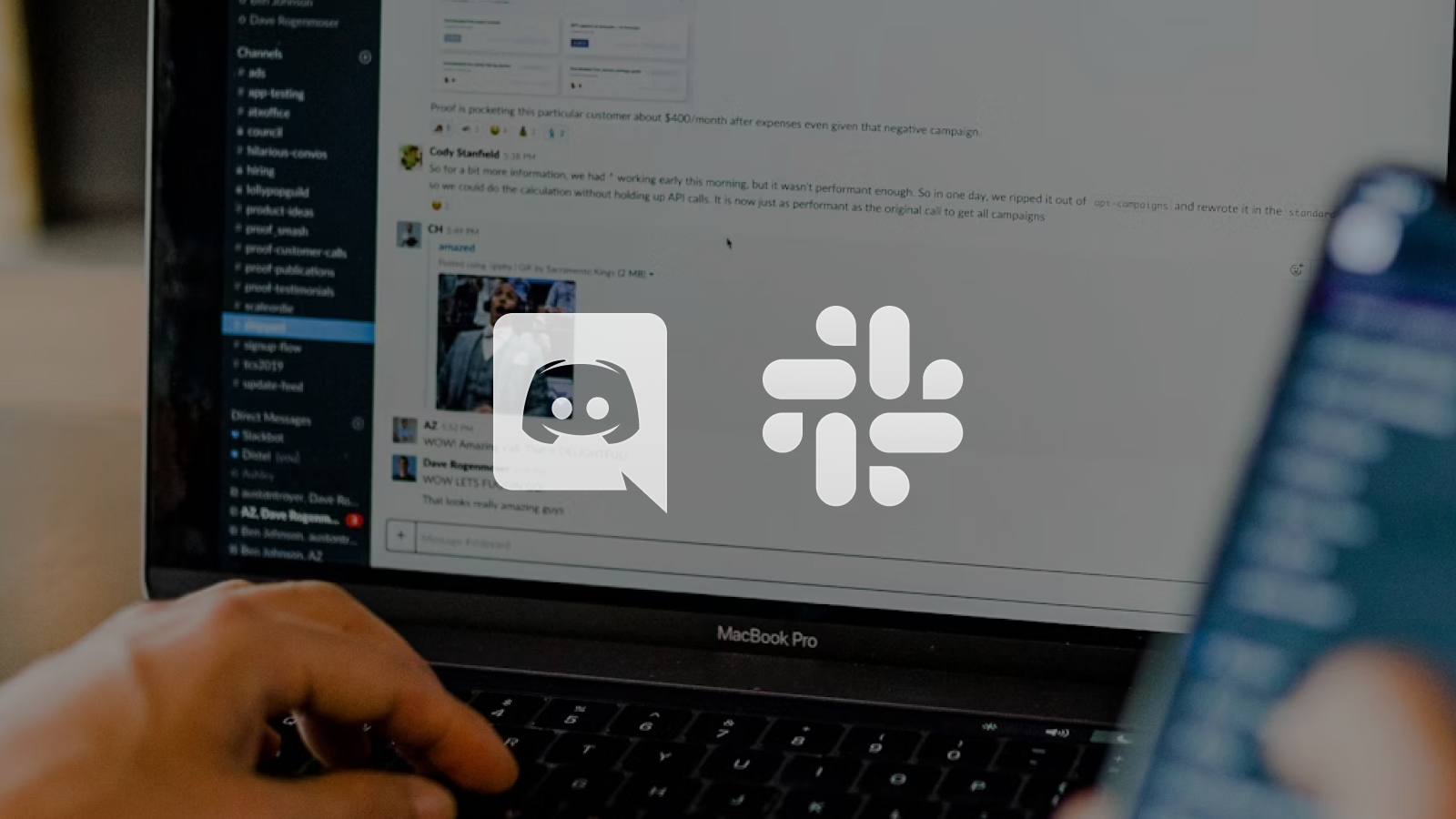Slack and Discord serve different purposes, making the choice complex for business teams using collaboration tools. Discord costs almost nothing and offers unlimited message history. Slack charges $9+ per user monthly and deletes your messages after 90 days on the free plan. Yet most businesses still pick Slack. Here’s why that happens and which team communication software actually makes sense for your team.
The core difference is simple: Slack builds for productivity, Discord builds for community. Everything else flows from that choice.
Quick Comparison Overview
- Target: Slack for business productivity, Discord for community building
- Free plan: Discord wins (unlimited history vs 90 days)
- Pricing: Discord significantly cheaper
- Integrations: Slack dominates (2,600 vs limited)
- Voice calls: Discord supports more users (5,000 vs 15)
- Business features: Slack has proper enterprise tools
Slack vs Discord: Complete feature comparison
| Feature | Slack | Discord |
|---|---|---|
| Free plan message history | 90 days | Unlimited |
| Paid plan pricing | $9/user/month | $10/user/month |
| Voice call participants | 15 users max | 5,000 users max |
| Third-party integrations | 2,600+ apps | Limited |
| AI features | Yes (Business+ plan) | No |
| Screen sharing | Yes | Yes |
| Thread organisation | Excellent | Basic |
| Enterprise security | Full compliance | Basic |
| File sharing limits | Plan dependent | 8MB free/100MB paid |
| Search functionality | Advanced | Basic |
Slack for business: strengths and weaknesses
Strengths
Integration ecosystem: Slack connects to 2,600+ business tools including GitHub, Salesforce, Google Workspace, and Trello. No other platform comes close.
Organisation: Threaded conversations keep discussions focused. Channel structure organises teams and projects clearly.
Enterprise features: SAML single sign-on, compliance controls, audit logs, and data retention policies meet business requirements.
AI capabilities: Conversation summaries, file analysis, and smart search (Business+ plan only).
Weaknesses
Price: Minimum $27 monthly for three users on Pro plan. Business+ costs $18 per user monthly for AI features.
Message history limits: Free plan deletes messages after 90 days. Painful for growing teams.
Voice limitations: Maximum 15 participants in voice calls. Basic video features compared to competitors.
Complexity: Learning curve for new users. Interface feels cluttered with too many features.
Discord for teams: pros and cons
Strengths
Generous free plan: Unlimited message history, group voice and video calls, community features and bots. No artificial limits.
Voice excellence: Up to 5,000 users in voice channels. Always-on voice rooms perfect for quick chats.
Cost effective: Nitro plans start around $10 monthly for enhanced features. No per-user pricing pressure.
Real-time focus: Built for instant communication and spontaneous collaboration.
Weaknesses
Limited business integrations: Few connections to work tools like CRM, project management, or accounting software.
Organisation chaos: No threaded conversations. Large teams create message overload quickly.
Professional perception: Discord’s gaming reputation hurts adoption in traditional businesses.
Security gaps: Missing enterprise compliance features, audit trails, and granular permission controls.
Hidden Costs and Considerations
Slack’s gotchas:
- Three-user minimum billing even for smaller teams
- AI features locked behind $18/user Business+ plan
- Integration limits on free plan (10 apps maximum)
- Guest user pricing adds up quickly
Discord’s limitations:
- File upload limits (8MB free, 100MB paid)
- No built-in project management or task tracking
- Limited search functionality compared to Slack
- Missing compliance features for regulated industries
How to Choose the Right Platform
Choose Discord if:
- Budget is tight (generous free plan)
- Voice communication is central to your workflow
- Team size stays under 20 people
- Work style is informal and community-focused
- You don’t need extensive business tool integrations
Choose Slack if:
- You need deep integration with business software
- Organised, threaded conversations matter
- Enterprise security and compliance are required
- Team size exceeds 50 people
- You can justify the monthly cost per user
Consider Cushion as a third alternative
Slack and Discord both compromise on key features. Slack’s pricing can hurt growing teams, while Discord lacks business features. Most teams want something in between: professional tools without the enterprise price tag.
Cushion solves this middle-ground problem. You get unlimited message history from day one, no user minimums, and proper project organisation. Unlike Discord, it’s built for work. Unlike Slack, it won’t bankrupt your startup.
Many teams use Cushion for internal discussion and keep Slack for external client communication through Slack Connect. You get the best of both worlds: professional collaboration internally and network effects externally.
The pricing makes sense too. No sudden jumps when you need basic features like message history or AI summaries.
TLDR
Discord wins on price and voice features but lacks business integrations. Slack dominates enterprise features but costs significantly more. Neither platform perfectly serves growing businesses that need professional tools without enterprise complexity.
For most small to medium teams, Discord’s free plan offers better value than Slack’s limited free tier. However, if you depend on business software integrations or need threaded organisation, Slack justifies its cost.
Consider Cushion for internal team collaboration while keeping Slack for client communication. You’ll save money, keep your message history, and avoid Discord’s business credibility issues.
